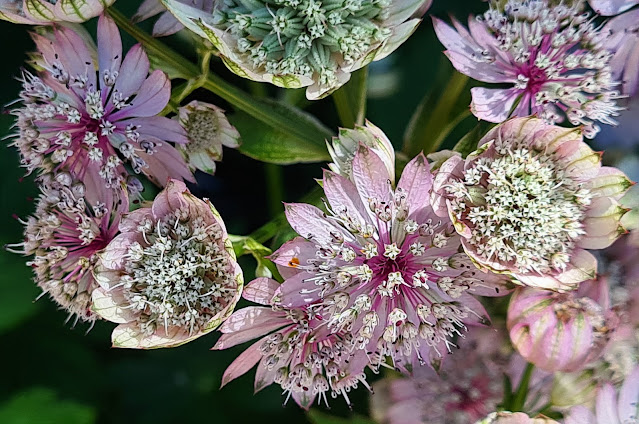Starry flowerhead a condensed carrot bloom
The Great Masterwort, which I prefer to Star of Beauty despite or because of the Harry Potter vibe, is a carrot. Or at least a carrot relative, like the ornamental Angelica, the local Xanthosia and other edibles such as celery, fennel and coriander.
I photographed this Astrantia major at Cloudehill, in the Dandenongs, back in late January. Like me, it was enjoying a shady nook in mid-summer.
It's one of eight species of Astrantia, a genus from Europe and western Asia, with the Great Masterwort from mountain meadows and grasslands in southern Europe through to Turkey. There are lots of cultivars, in varying shades of pink and red, so I'm not going attempt an identification for this one.
If you take a close look at the flower you can see that the typical umbel (umbrella) of the carrot flower has been condensed into a compact flowerhead with lots of individual flowers surrounded by the pretty pink bracts.
These umbels have a mix of bisexual flowers (with male and female parts) and male flowers. You can see this mix in the next image, in the righthand flower, with the male flowers having only a thin (often pink) stalk. At the left is a flower with developing fruits but no obvious surviving male flowers.
The genus name Astrantia is from the Latin word for star, 'astrum', and the species name, 'major', of course means big or significant. Both names refer to the flowerhead and were bestowed by Carl Linnaeus in 1753, at the dawn of botanical nomenclature.
The leaves are what we call palmate (hand-shaped) like a maple leaf, with a smattering of tiny hairs.
Like many plants in the carrot family, it contains some interesting volatile oils which may or may not have value to humans. Such chemicals give many species in this family a whiff of carrot when you crush their leaves. Less pleasantly, Giant Masterwort has been rated as of minor medicinal, with possible applications as a diuretic and purgative.
Visually, a very pretty plant and if you can track down the stronger pink cultivars, they are even more striking.





Comments